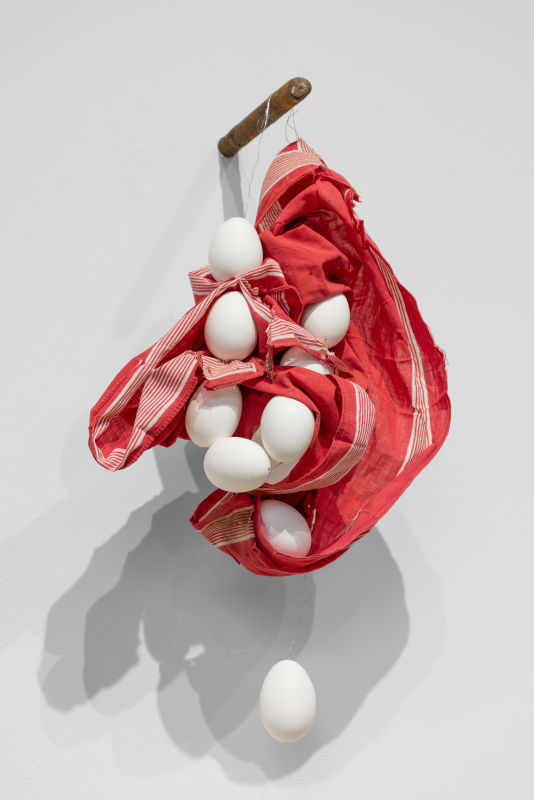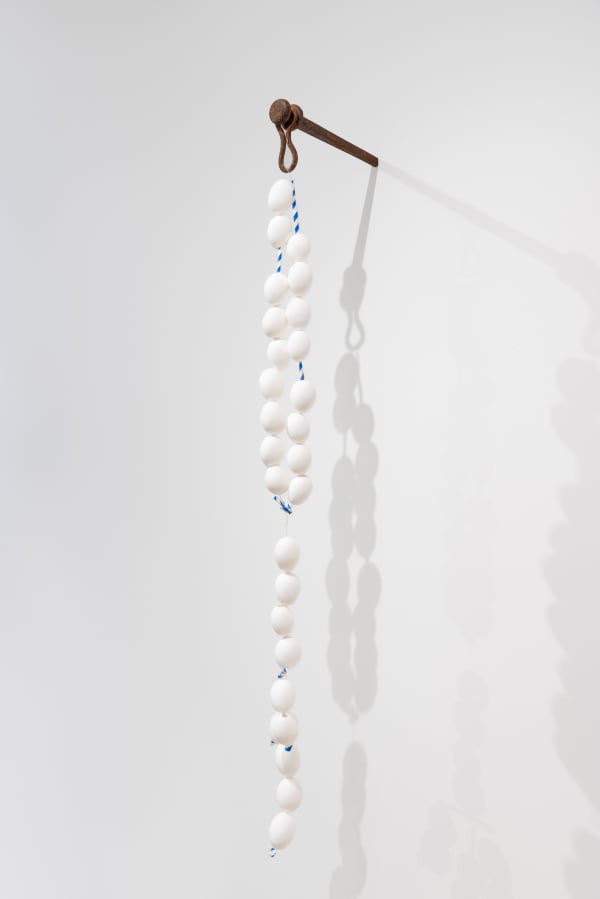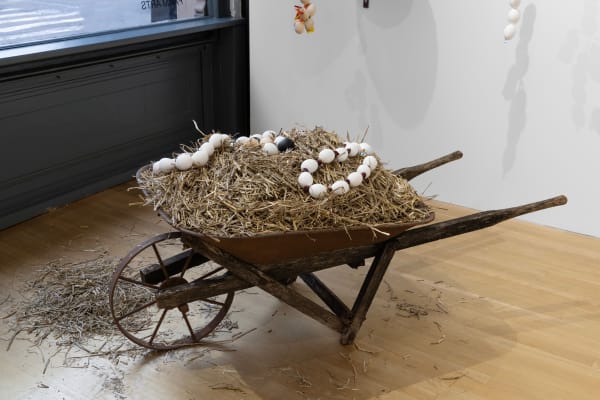Erik van Lieshout: FARM ARTS at WINDOW: WINDOW, 91 Walker Street New York, NY (corner of Walker and Lafayette Street)
Welcome to FARM ARTS, a faux shop filled with marvelous objects made by Dutch artist Erik Van Lieshout including egg necklaces, hay sculptures, farm tool wall hangings (of the hoe, shovel, axe variety), bandana-wrapped egg jewelry, a worn-out wheelbarrow, and a suspended fourteen-pronged egg-pitchfork. Discarded farm implements are reshaped into improbable personal ornaments. The silhouette of an old-fashioned ploughman, hand-cut out of black vinyl, envelops the space.
A short video in the Lafayette Street window hints at the origin of these objects, their background story, the larger context. We see Van Lieshout carrying an enormous replica of a chicken egg on his back, struggling under the heavy burden, through a desolate landscape, passing abandoned farm buildings, neglected fields, concrete barriers, and overgrown roads. Moments later, eggs from a chicken farm are being counted and packed, and the artist finds rest at an egg-vending machine (€ 6,50 for 30 eggs). There, he begins to blow out eggs, yolk and egg white oozing out of the emptied shells; finally, Van Lieshout is modeling his newly made egg necklaces for us, and he has invited local dignitaries to do the same. But where are we and what has happened?
In 2019, a Dutch court ruling led to a crackdown on nitrogen emissions caused by large, heavily polluting livestock companies. Many farmers felt betrayed by the about-turn in agricultural policy leading to protests, social polarization, and the birth of a new political party, the BBB (Farmer–Citizen Movement). The cumulative effects have been seismic. Nitrogen is used in chemical fertilizers to produce the soy that, in turn, is fed to livestock. The combined feces and urine of animals that are crowded into barns leads to more nitrogen, which evaporates as atmospheric ammonia. By far the largest share of nitrogen deposited on Dutch land comes from agriculture, so the proposed measures would need to involve, according to a committee’s report, buying out and shutting down livestock farms. The report did not make clear whether these buyouts would be voluntary or forced. Farmers assumed the worst.
From April to December 2023, Erik van Lieshout visited his old hometown of Deurne, North Brabant, which is known for its residents' fierce opposition to the nitrogen policy. Here Van Lieshout worked and filmed for months on a dilapidated farm in the much-discussed area of De Peel, where millions of pigs and chickens are confined in mega-stalls. The artist documents the antagonism between environmentally concerned bureaucrats and farmers who have worked the land for decades.
Arising from this stay is Van Lieshout’s latest film entitled The Fen-Fire, of which FARM ARTS constitutes a short excerpt and a sculptural installation. The Fen-Fire, combines politics, land art, craft, and landscape myths to raise questions about the past, the current state, and the future of De Peel. In the film, Van Lieshout works with remnants of the farm to create his own version of what he calls farmers' art. Additionally, the film touches on themes such as poverty, odor circles, migrant workers, protests, the housing crisis, and the so-called Natura 2000. With the Brabant dialect and humor as common denominators, the artist speaks with farmers, civil servants, environmental activists, and residents about the landscape, their connection to the land, the meaning of nature, and political regulations.
Van Lieshout, who is known for his radical, interventionist and humorous films, sees FARM ARTS as a gentle introduction to complex social and ecological issues, not only in the Netherlands.
-
 Erik van LieshoutFarm Arts object #1 (bandana), 2024
Erik van LieshoutFarm Arts object #1 (bandana), 2024 -
 Erik van LieshoutFarm Arts object #2 (hoe), 2024
Erik van LieshoutFarm Arts object #2 (hoe), 2024 -
 Erik van LieshoutFarm Arts object #3 (metal hook and necklace), 2024
Erik van LieshoutFarm Arts object #3 (metal hook and necklace), 2024 -
 Erik van LieshoutFarm Arts object #4 (shovel), 2024
Erik van LieshoutFarm Arts object #4 (shovel), 2024















